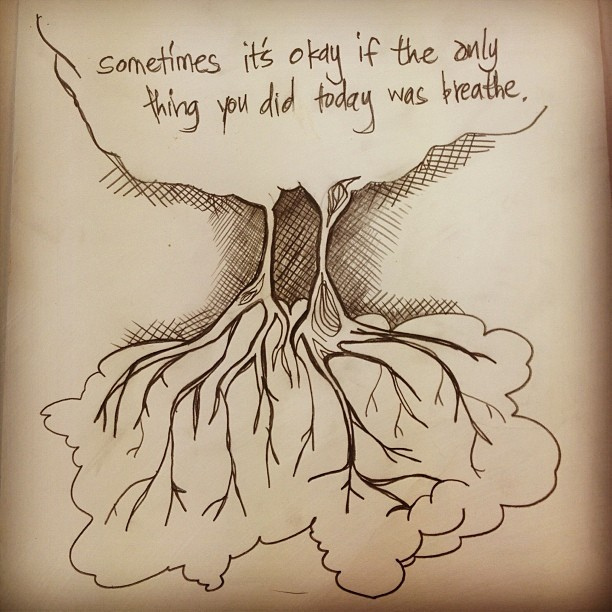I didn’t enjoy focusing on my breath when I first started practicing yoga.
Why focus on breathing when the body is what matters? It was boring and I didn’t understand why we spent so much class time reviewing the act of breathing. Many yoga classes later, I looked around and noticed myself roaring and heaving and sighing like the seasoned yogis around me. It was then that I realized how fundamental breathing is to the practice of yoga asana.
Fast-forward several years, and I’m still happily enjoying my adventure in breathing—both as a student and a yoga teacher. The breath has become the forefront of my personal practice as well as a priority when I’m teaching.
I’ve had many teachers (with lineages spanning from the classics of Iyengar and Anusara, to modern interpretations like Strala and Vinyasa) and experiences that transformed me from a breath naysayer to its biggest champion. One of my most influential experiences on this breath-journey actually came through a YouTube video with Leslie Kaminoff, in which he explains what our first breath as newborns is like. Contextualizing the breath in this way added depth of meaning for me. As I started seeing sustainable transformation in my asana practice, I began to look for more of his insight.
Leslie is a world-renowned yoga teacher. Over the last 30 years he’s contributed quite a bit to what we know about yoga anatomy and breathing. I was fortunate to listen to a recent interview he gave with Pilgrimage of the Heart Yoga in San Diego, where he shared his thoughts on what makes breathing so important in the yoga practice.
After listening to the podcast, I took three major takeaways that confirmed my own relationship with breath. I pass these along to everyone who will listen.
1. The Breath Mobilizes
“The posture work of asana is how you stabilize your body in space, and breath would be more about how you mobilize the space in your body.”
There is a fundamental relationship between body movement and breath. Leslie refers to it as “two sides of the same coin.” The breathing muscles are the same muscles used to accomplish the postural work in yoga asana, which means that the quality of the breath is reflected in the pose, and vice versa. Weakness in breathing will show up in the body as discomfort or injury, and ignorance about the body (and its boundaries) will show up in the breath as constriction.
Each pose requires a stable body so that the breath can fill it with movement potential. When movement arises from efficient breathing (instead of mental desire), the body can respond by intensifying or softening the effort of a yoga pose without feeling uncomfortable. It’s like a call-and-response system of communication.
When used in this way, breath has the potential to counter all of the stresses that the body undergoes during everyday life and asana practice. It is the unseen force that makes a challenging pose, easy; an easy pose, active; and a restorative pose, present.
2. Learning What’s Changeable
The breath teaches us about what’s essentially changeable and unchangeable about our bodies. For Leslie, the breath illustrates this concept because it’s both voluntary and automatic. In other words, part of it is changeable and part of it isn’t, so the breath is capable of training us about the fixed and transformative parts of ourselves.
Leslie says, “Not every asana is for every person, not every person’s body can do every pose.” This is due to a web of unchangeable features in our bodies. Our genetics, connective tissue and joint structure will predispose us to have an easier time with some yoga poses and a harder (or even contraindicated) time with others.
For example, I love hip-opening postures, but due to the shape of my pelvis and thighbones, external rotation is very limited for me. This means I can’t expect my Warrior II, Half Moon or Triangle Poses to suddenly take me into hip-heaven. I used to push back on postures like this, hoping to change my body’s boundaries, but doing this would make my breath short and shallow. Now that I know better, I’m able to adjust my bones to the pose so that my breath is free and mobilizing.
By studying the breath, we naturally learn what is and isn’t changeable. If we’re pushing on an unchangeable boundary—let’s say the limit of the bones in a Triangle Pose—the breath will inform us by minimizing space in the body. On the other hand, if we’re pushing on a changeable boundary—let’s say enduring a long Chair Pose—the breath will change our capacity by becoming expansive and more supportive. In this way, we can focus our efforts on areas that we can actually improve. This not only yields results, it ultimately keeps us safe in asana practice.
3. The Value of Technique
Have you ever wondered why we spend so much time learning how to breathe correctly in yoga class? Why we take time to constrict our throats for Ujjayi breath or plug the nostrils for alternate-nostril breathing? What do we get out of learning a technique?
Regardless of lineage or tradition, every technique has a set of guidelines—there is a right way and wrong way to do them. By studying a technique and their guidelines, we must unlearn our old ways of breathing. In this process, we discover personal habits and patterns (that we may have previously been unaware of) that get in the way of our ability to practice the technique correctly. It’s a way to make the invisible more visible.
Leslie says, “When you learn to do (a technique) right, what you’re discovering in your system is all the stuff that gets in the way. Dealing with the stuff that gets in the way is really what the work is.”
Breathing techniques will differ depending on the style of yoga we choose and the teachers we practice with. We may find that we’re naturally interested in one technique over another, or that our preferred technique changes over time. The fundamental usefulness of a technique—whichever one we choose—is that it’s designed to reflect our previously unseen conditioning back to us so that we can understand it (and ultimately become free of it).
You can see how practicing a technique, and the understanding we derive from it, has major implications for our day-to-day psychology, relationships and jobs. It’s a way to purify the mind and body from old habits and belief systems that aren’t true.
We must also remember that techniques are not breathing rules for life.
Sure, it may be useful to take cleansing breaths in stressful life situations, but that doesn’t mean we should be taking cleansing breaths all the time. Leslie says this is because “There’s no one pattern or technique that will suffice for everything you need to do with your body and breath.” The purpose of a technique is to free our body-mind system to respond spontaneously to the needs of each moment, where otherwise our mindless conditioning might respond for us.
In other words, technique is for practice, spontaneity is for life.
I used to see the breath as an unnecessary distraction that took away from my workout, but now it’s the reason I show up to practice. Shifting my perspective about the breath opened up a whole new dimension of yoga exploration and growth.
It is the mobilizing force within us, the teacher of our body’s fundamentals, and the path by which we learn to respond freely and spontaneously from moment to moment. It is the intelligence keeper of the body and mind, and our job is simply to be open to its transformational power.
It is our master yoga teacher, and all answers lie within its domain. We just have to ask.
Take the next step into breath.
~
Author: Brentan Schellenbach
Image: Buttermilk/Flickr
Editor: Caitlin Oriel


 Share on bsky
Share on bsky





Read 0 comments and reply